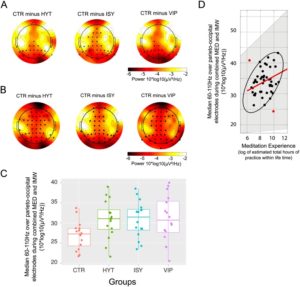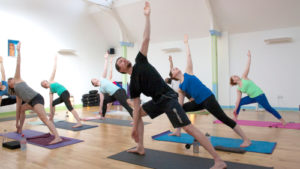Improve Quality of Life and Performance with Multiple Sclerosis with Yoga
By John M. de Castro, Ph.D.
“Studies in multiple sclerosis, these have shown that mindfulness can improve quality of life and help people cope better with their MS. The studies also found that it decreased stress, anxiety and depression.” – Multiple Sclerosis Trust
MS is a progressive demyelinating disease which attacks the coating on the neural axons which send messages throughout the body and nervous system. It affects about 2 million people worldwide and about 400,000 in the U.S. It is most commonly diagnosed in people between the ages of 20 and 50 years. Unfortunately, there is no cure for multiple sclerosis. There are a number of approved medications that are used to treat MS but are designed to lessen frequency of relapses and slow the progression of the disease, but they don’t address individual symptoms.
Although there is a progressive deterioration, MS is not fatal with MS patients having about the same life expectancy as the general population. Hence, most MS sufferers have to live with the disease for many years. So, quality of life becomes a major issue. Quality of life with MS is affected by fatigue, cognitive decrements, physical impairment, depression, and poor sleep quality. There is a thus a critical need for safe and effective methods to help relieve the symptoms of MS and improve quality of life. Mindfulness has been previously shown to improve depression, sleep quality, cognitive impairments, emotion regulation, and fatigue. Yoga is a mindfulness practice that has the added feature of exercising and stretching the muscles. It would seem likely that yoga practice might be an ideal treatment for improving the quality of life and lessening symptoms in patients with multiple sclerosis.
In today’s Research News article “Feasibility and Impact of an 8-Week Integrative Yoga Program in People with Moderate Multiple Sclerosis–Related Disability: A Pilot Study.” See summary below or view the full text of the study at:
https://www.ncbi.nlm.nih.gov/pmc/articles/PMC5315321/
Cohen and colleagues performed a pilot, single-group study, of the effectiveness of a specially designed yoga program for treating patients with multiple sclerosis. They recruited adult patients with multiple sclerosis with moderate disability and provided them with 8 weeks of twice weekly, 90-minute yoga sessions, including breathing practices, postures, meditation, and deep relaxation. The patients were encouraged to also practice at home. They assessed the feasibility of widespread implementation of such a program with budget utilization, recruitment rates, retention rates, attendance rates, and safety. They also assessed the patients’ quality of life, walking ability, extremity function, respiration, attention, and concentration, prior to and after the 8-week program and also 8-weeks later.
They found that the program was feasible, as it was implemented with acceptable costs, high participation rates and low drop-out rates, no unexpected adverse effects, and all participants reported home yoga practice. Importantly they found that after the intervention the patients were significantly improved on overall health status, quality of life issues, including bladder control, perceived deficits, and fatigue, standing, walking ability, motor control of both hands, hearing, and seeing. Many of these improvements continued to be significant at the 8-week follow-up.
Hence, this pilot study demonstrated the feasibility and potential benefits of yoga for patients with multiple sclerosis. This study did not contain a control condition, so any conclusions must be tempered and recognized as preliminary. Any exercise program might have produced similar benefits. A randomized controlled clinical trial is needed and warranted. But, the results were impressive and suggest that yoga for patients with multiple sclerosis can improve their quality of life and physical and mental ability and well-being. Since, multiple sclerosis produces a life-long disability, and yoga was shown to be both safe and effective, can be practiced at home, and substantially improves quality of life and motor ability, it would seem to be ideal to improve the lives of these patients.
So, improve quality of life and performance with multiple sclerosis with yoga.
“Mind-body therapies like yoga are also a practical therapeutic approach in MS because of their low risk of physical or emotional stress. The exercise of yoga also allows people with MS to engage in their treatment in a very active and engaged manner. there appears to be benefit in MS from participation in any regular physical activity like yoga. yoga may additionally improve cognitive ability by exercising one’s attention on focused breathing and positioning techniques and by generally improving mood and reducing stress.” – Edward Kim
CMCS – Center for Mindfulness and Contemplative Studies
This and other Contemplative Studies posts are also available on Google+ https://plus.google.com/106784388191201299496/posts and on Twitter @MindfulResearch
Study Summary
Cohen, E. T., Kietrys, D., Fogerite, S. G., Silva, M., Logan, K., Barone, D. A., & Parrott, J. S. (2017). Feasibility and Impact of an 8-Week Integrative Yoga Program in People with Moderate Multiple Sclerosis–Related Disability: A Pilot Study. International Journal of MS Care, 19(1), 30–39. http://doi.org/10.7224/1537-2073.2015-046
Abstract
Background:
This pilot study determined the feasibility of a specifically designed 8-week yoga program for people with moderate multiple sclerosis (MS)–related disability. We explored the program’s effect on quality of life (QOL) and physical and mental performance.
Methods:
We used a single-group design with repeated measurements at baseline, postintervention, and 8-week follow-up. Feasibility was examined through cost, recruitment, retention, attendance, and safety. Outcomes included the Multiple Sclerosis Quality of Life Inventory (MSQLI), 12-item Multiple Sclerosis Walking Scale (MSWS-12), Timed 25-Foot Walk test (T25FW), 6-Minute Walk Test (6MWT), Nine-Hole Peg Test (NHPT), Five-Times Sit-to-Stand Test (FTSTS), Multidirectional Reach Test (MDRT), maximum expiratory pressure, and Paced Auditory Serial Addition Test-3″ (PASAT-3″).
Results:
Fourteen participants completed the study. The program was feasible. There were significant main effects on the 36-item Short Form Health Status Survey Mental Component Summary (SF-36 MCS), Modified Fatigue Impact Scale (MFIS), Bladder Control Scale (BLCS), Perceived Deficits Questionnaire (PDQ), Mental Health Inventory (MHI), MSWS-12, T25FW, NHPT, PASAT-3″, 6MWT, FTSTS, and MDRT-Back. Improvements were found on the SF-36 MCS, MFIS, BLCS, PDQ, MHI, and MSWS-12 between baseline and postintervention. The effect on PDQ persisted at follow-up. Improvements were found on the T25FW, NHPT, 6MWT, FTSTS, and MDRT-Back between baseline and postintervention that persisted at follow-up. The PASAT-3″ did not change between baseline and postintervention but did between postintervention and follow-up.
Conclusions:
The yoga program was safe and feasible. Improvements in certain measures of QOL and performance were seen at postintervention and follow-up.
https://www.ncbi.nlm.nih.gov/pmc/articles/PMC5315321/





